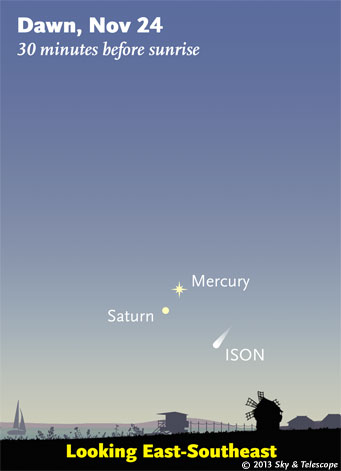
Where to look for Comet ISON low in early dawn. On Saturday morning the 23rd, it's directly right of Mercury and Saturn. It's dropping lower and becoming much harder to detect every day! Mercury and Saturn are much brighter; start with them to find the spot to examine for the comet with binoculars or a wide-field telescope. The comet symbol is exaggerated.
For scale, these scenes are two or three times as wide as your fist held at arm's length.
The illustrations are free to reproduce anywhere with credit including a link to SkyandTelescope.com.
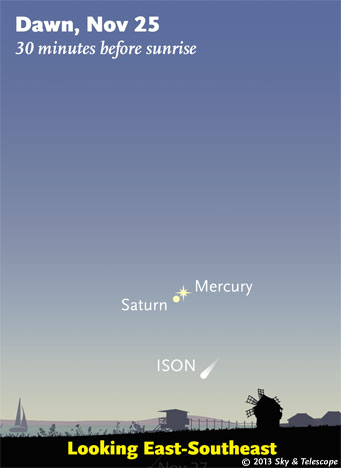
Getting much harder....
Comet ISON is becoming a lot harder to spot with binoculars or (better) a telescope as it moves lower in the brightening dawn — even as the comet brightens day by day, racing toward its November 28th perihelion. See our Latest Updates on Comet ISON and our press release (with free-for-use high-res graphics) Comet ISON Brightening as its Moment of Truth Nears.
Meanwhile, Comet Lovejoy C/2013 R1 remains much higher and easier to see in binoculars before dawn even begins. It's 5th magnitude and in Canes Venatici, south of the Big Dipper's handle. Use our finder chart.
Friday, November 22
Saturday, November 23
Sunday, November 24
In a telescope, Mercury will be a tiny, slightly gibbous disk 5.6 arcseconds in diameter (no bigger than Mars, high in the southeast), while Saturn is dimmer but much larger: 34″ across its rings. They're a nice consolation prize!
Monday, November 25
Tuesday, November 26
Wednesday, November 27
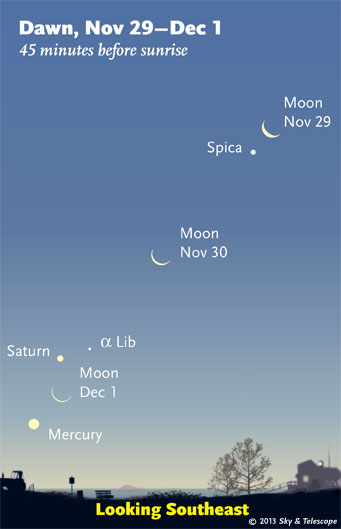
The waning Moon passes Spica as it descends the dawn sky. (The Moon's position is drawn for the center of North America.)
Sky & Telescope diagram
Thursday, November 28
Friday, November 29
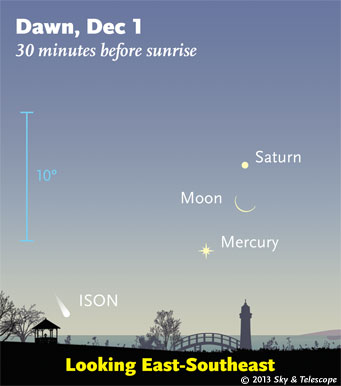
What will have emerged from the comet's graze around the Sun? (The blue 10° scale bar is about the width of your fist at arm's length.)
SkyandTelescope.com
Saturday, November 30
Want to become a better astronomer? Learn your way around the constellations. They're the key to locating everything fainter and deeper to hunt with binoculars or a telescope.
This is an outdoor nature hobby. For an easy-to-use constellation guide covering the whole evening sky, use the big monthly map in the center of each issue of Sky & Telescope, the essential guide to astronomy. Or download our free Getting Started in Astronomy booklet (which only has bimonthly maps).
Once you get a telescope, to put it to good use you'll need a detailed, large-scale sky atlas (set of charts). The standards are the little Pocket Sky Atlas, which shows stars to magnitude 7.6; the larger and deeper Sky Atlas 2000.0 (stars to magnitude 8.5); and once you know your way around, the even larger Uranometria 2000.0 (stars to magnitude 9.75). And read how to use sky charts with a telescope.

The Pocket Sky Atlas plots 30,796 stars to magnitude 7.6 — which may sound like a lot, but that's less than one star in an entire telescopic field of view, on average. By comparison, Sky Atlas 2000.0 plots 81,312 stars to magnitude 8.5, typically one or two stars per telescopic field. Both atlases include many hundreds of deep-sky targets — galaxies, star clusters, and nebulae — to hunt among the stars.
Sky & Telescope
You'll also want a good deep-sky guidebook, such as Sue French's Deep-Sky Wonders collection (which includes its own charts), Sky Atlas 2000.0 Companion by Strong and Sinnott, the bigger Night Sky Observer's Guide by Kepple and Sanner, or the beloved if dated Burnham's Celestial Handbook.
Can a computerized telescope replace charts? Not for beginners, I don't think, and not on mounts and tripods that are less than top-quality mechanically (able to point with better than 0.2° repeatability, which means heavy and expensive). As Terence Dickinson and Alan Dyer say in their invaluable Backyard Astronomer's Guide, "A full appreciation of the universe cannot come without developing the skills to find things in the sky and understanding how the sky works. This knowledge comes only by spending time under the stars with star maps in hand."
This Week's Planet Roundup
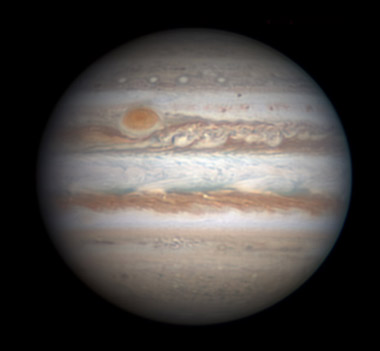
Jupiter on November 24th. Note the vivid orange color of the Great Red Spot now, and the massive white turbulence trailing far behind it in the South Equatorial Belt. South is up.
Mercury and Saturn are together low in the dawn with Comet ISON passing nearby. Look very low in the east-southeast during dawn, far lower left of Spica. Mercury is magnitude –0.7; Saturn is one-third as bright at +0.6. They pass each other less than 1° apart on the mornings of the 25th and 26th, as shown above.
Venus (magnitude –4.8) is the brilliant "Evening Star" in the southwest during dusk, shining about as high and bright as it's going to this year. It sets more than an hour after dark. In a telescope, Venus has waned to its thick-crescent phase and has enlarged to about 34 arcseconds tall.
Mars (magnitude 1.3, below the hind feet of Leo) rises around 1 a.m. By dawn it's high in the southeast. In a telescope Mars is still tiny, 5.5 arcseconds wide.
Jupiter (magnitude –2.5, in Gemini) rises in the east-northeast around 8 p.m., with Pollux and Castor to its left. It blazes highest around 3 a.m. In a telescope Jupiter has grown to 44 arcseconds wide, as it heads toward its January 5th opposition.
Uranus (magnitude 5.7, in Pisces) and Neptune (magnitude 7.9, in Aquarius) are high in the southern sky in early evening. Finder charts for Uranus and Neptune.
All descriptions that relate to your horizon — including the words up, down, right, and left — are written for the world's mid-northern latitudes. Descriptions that also depend on longitude (mainly Moon positions) are for North America.
Eastern Standard Time (EST) is Universal Time (UT, UTC, or GMT) minus 5 hours.
Like This Week's Sky at a Glance? Watch our SkyWeek TV short, also playing on PBS.
To be sure to get the current Sky at a Glance, bookmark this URL:
http://SkyandTelescope.com/observing/ataglance?1=1
If pictures fail to load, refresh the page. If they still fail to load, change the 1 at the end of the URL to any other character and try again.
 0
0
Comments
You must be logged in to post a comment.